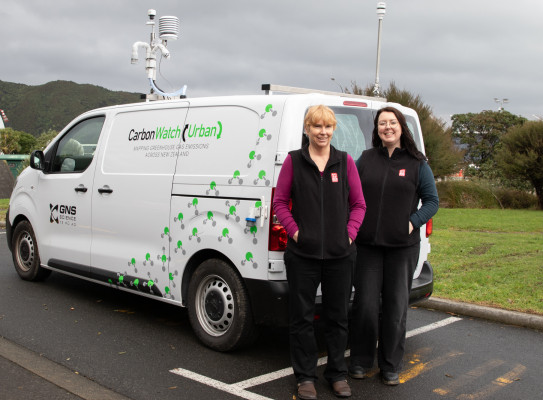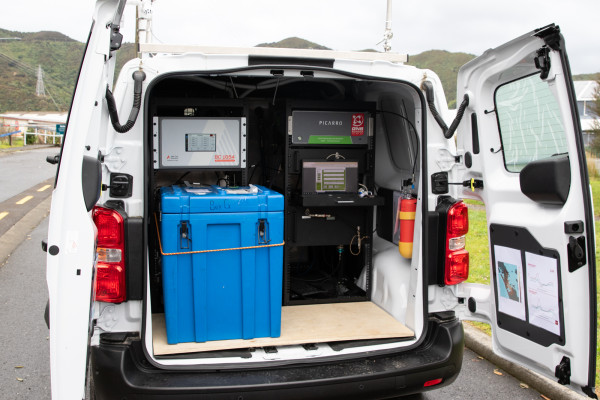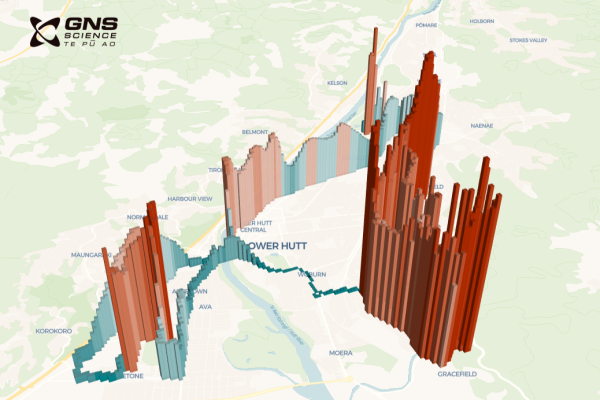World-first mobile greenhouse gas lab hits the road to measure urban emissions

GNS Science’s custom-designed CarbonWatch-Urban mobile lab is gathering vital information to help Aotearoa New Zealand meet our net-zero 2050 target.
Understanding how much carbon dioxide is released by our cities and towns, and how much is absorbed by green spaces, is key for effective development choices and mitigation policies to support our transition to a low-carbon economy.
The five-year CarbonWatch-Urban research programme, led by GNS Science, is mapping the carbon dioxide (CO2) sources and sinks for every town and city in Aotearoa, with the mobile lab playing a key role. The lab will gather measurements from urban areas across the country, spanning varying climates, geographies and population sizes, and visiting multiple times to account for seasonal variation.
Programme lead, Jocelyn Turnbull, says the mobile lab is a game-changer in the mission for robust urban emissions information.
"Getting accurate information into the hands of decision-makers is essential for emissions reduction. But, until now, only a handful of cities around the world - including Auckland - have had the instrumentation to achieve this."
Our mobile lab is a world-first, enabling us to provide this information for every town and city in New Zealand.
From the outside it may look like a humble van, but the mobile lab is anything but. Housed within the electric vehicle is an array of state-of-the-art instrumentation, modified to be road-trip ready, enabling a range of atmospheric measurements.
The impressive kit is powered by a stack of rechargeable batteries adapted from home-solar systems, to avoid draining the van’s electric battery.
"Squeezing all of this high-tech equipment inside the van, and providing a rechargeable electric power supply, has required a fair bit of kiwi ingenuity from our team and GNS’s engineering workshop," says Turnbull.

A roadtrip for real-time emissions data
The CarbonWatch-Urban mobile lab is starting out close to home, taking to the streets of Wellington over the next few months. The lab will collect data as they drive, mapping greenhouse gas concentrations around the city. The team will also stop at around 12 sites to do more detailed sampling, and collect flasks of air to take back to the world-renowned Rafter Radiocarbon Lab for additional analysis that can’t be done in the field.
Planning the itinerary for the national sampling is no mean feat, as they must factor in the diversity of sampling locations along with the range of the van and the availability of charging stations.
CarbonWatch-Urban is also extending the existing measurements and instrumentation at four permanent sites in Auckland that continuously measure greenhouse gases.
The researchers combine the atmospheric measurements with cutting-edge flux modelling. The flux modelling draws upon economic data such as fuel imports, vehicle counts, building information, and manufacturing data, as well as satellite measurements of "greenness" to create maps of emissions and sinks over space and time.
The end result will be highly detailed and spatially-resolved information, enabling government, iwi, urban planners, and industry to better monitor their emissions, target mitigation, and develop low-emissions policy.
"We’ll be the first country in the world to have high-resolution information for all our urban centres," says Turnbull.

-
What's inside the van?
The kit-out includes a device that can measure CO2, carbon monoxide and methane in real time. The instrument is so sensitive that the team can see the peaks in these greenhouse gases when a car drives past.
On one wall is the Flask Sampler, that allows the team to collect samples of air in 2-litre flasks to take back to the Rafter Radiocarbon Laboratory in Wellington for further analysis to understand how much of the CO2 is coming from fossil fuels, how much is from biological sources, and even track the amount of CO2 being absorbed by plants.
The Black Carbon aethalometer sits above the Flask Sampler, allowing the scientists to not only document these harmful pollutant emissions, but to use them to diagnose the amount of CO2 coming from traffic and wood burning.
A large empty metal box allows measurement of radon gas, providing an innovative way to accurately quantify the emissions of all the other gases.
Finally, a GPS and weather station sit atop the mobile lab, so that every measurement is fixed to the time and place that it was collected, and the team have a record of where the air arrived from.
-
CarbonWatch-Urban funders and partners
· CarbonWatch-Urban is funded through the Ministry of Business, Innovation and Employment Endeavour Fund. The project is led by GNS Science, with research partners NIWA, Manaaki Whenua Landcare Research, University of Auckland, Ministry for the Environment, StatsNZ and Ngāti Whātua Ōrākei.
-
Rafter Radiocarbon Laboratory
GNS Science’s Rafter Radiocarbon Laboratory is crucial to this work, providing high precision measurements of radiocarbon in CO2. It’s the oldest continuously operating radiocarbon facility in the world, with a long history in climate science – it was the first lab in the world to measure radiocarbon in atmospheric CO2 in 1954. It’s the only laboratory in New Zealand that can do these high precision measurements, and there are only a few others worldwide that can do so, so it has a vital role to play in understanding our carbon balance.

